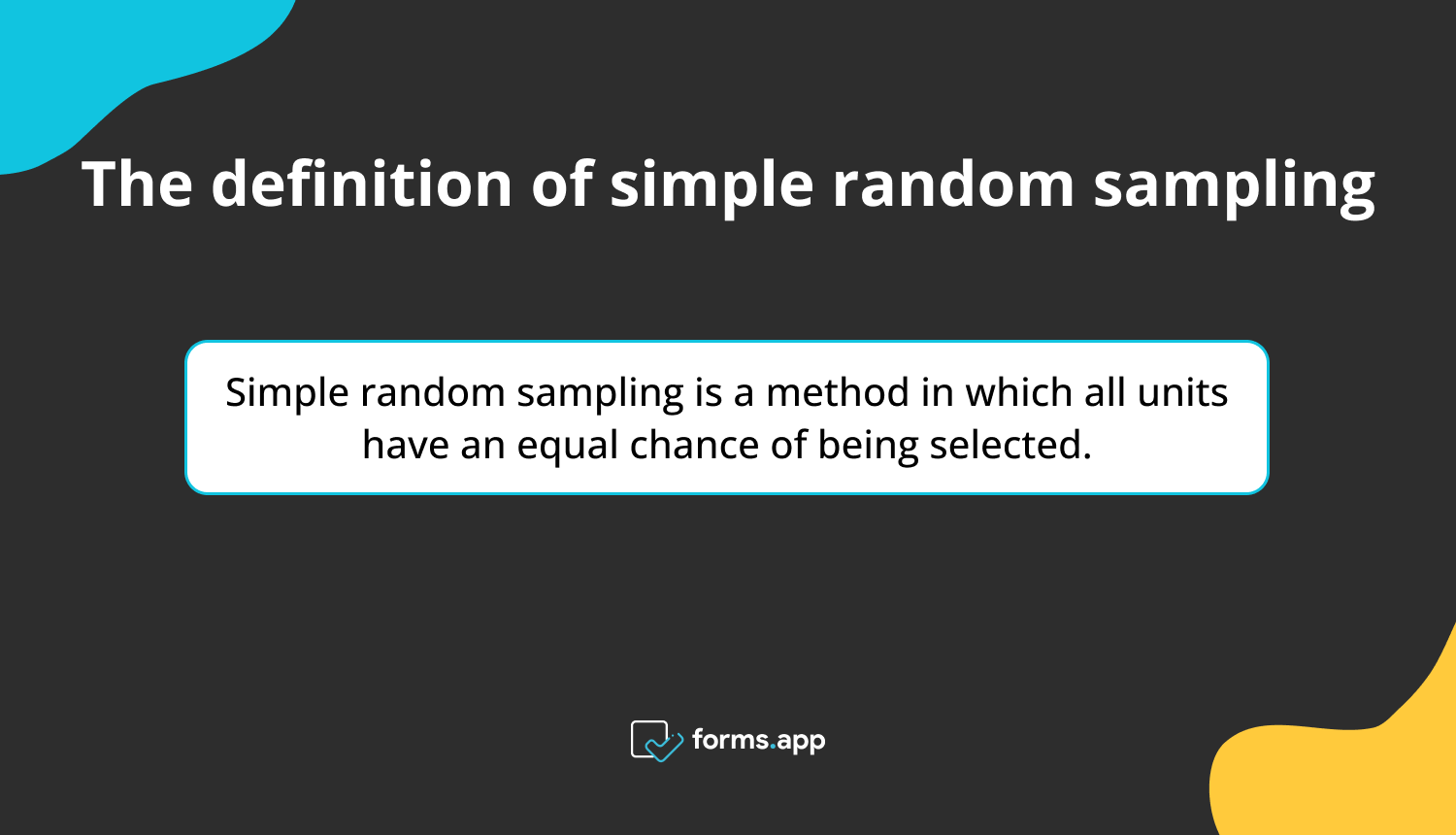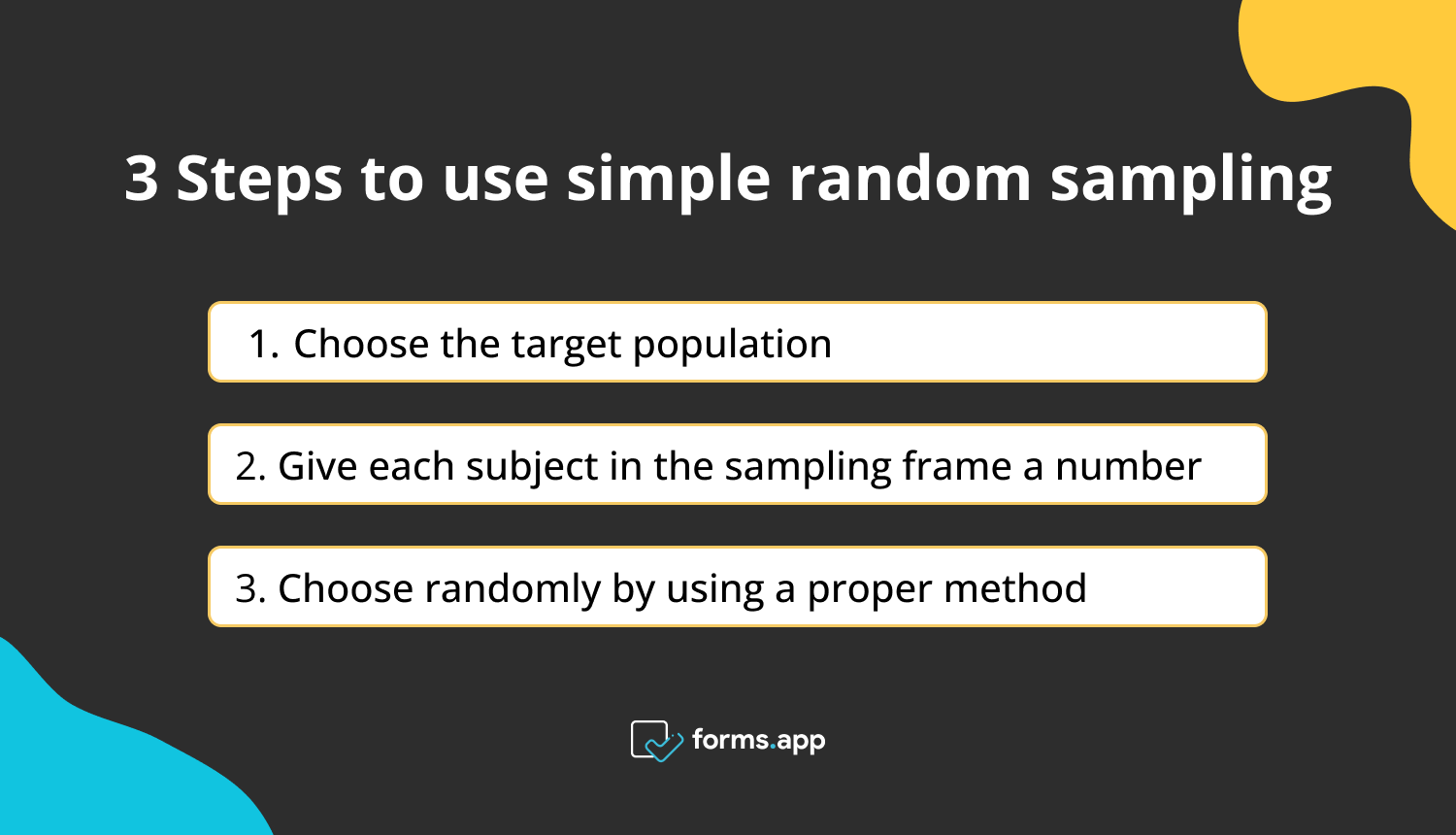Random samples represent the population, as they do not favor particular members. Simple random sampling is a crucial technique easily integrated into more advanced sampling techniques. Each sample has the same chance of being chosen, which is the main characteristic of this sampling technique.
Simple random sampling is a technique frequently used by researchers. This article will explain the definition of simple random sampling, its advantages and disadvantages, use cases, and how to use it easily.
What is simple random sampling?
Simple random sampling is a method in which all units have an equal chance of being selected. Every unit is listed, and one can be randomly chosen from the list. The selection process is simple if the universe is small and straightforward.
The evaluation process and sampling error can be calculated easily because the statistical operations in the sampling made with this method are performed without weights. The universe from which the sample will be drawn must be fully listed. Unit implementation can be messy and challenging.

The definition of simple random sampling
How to use simple random sampling (methods & steps)
In simple random sampling, all units are listed, and random units are selected from the list. You can follow the steps below to select a simple random sample. According to your study, you can choose a method by choosing one of the different simple random sampling method examples.
- The first step is to choose the target population you want to study and determine your desired sample size. Larger samples offer greater statistical confidence but cost more and involve much more work.
- Then, give each subject in the sampling frame, which is the list of sampled people, a sequential number.
- Finally, people are chosen using an appropriate selection technique. Each sample has an equal chance of being selected since the selection is random. You choose a portion of the population at random using a random number generator or a table of random numbers.

3 Steps to use simple random sampling
There are a few typical methods for selecting the required sample size from the population after the numbers have been assigned:
1 - Method:Lottery technique
The lottery system is the most physical and old-fashioned application of random sampling. According to this technique, each person in the population is given a number. To choose samples, the researcher used random numbers.
2 - Method: Random number tables
A technique that also involves counting the population is using random numbers. You can choose specific columns and rows for your sample group based on the selected sample size after creating a random numbers table with the serial numbers of your target population.
3 - Method: Online random number generator
Many online tools are available where the analyst enters the population and sample size to be selected. Using these tools, you can quickly choose your simple random sample. This method is both easy and time-saving.
Use cases of simple random sampling
When studying smaller data sets, it is always a good idea to use simple random sampling. It's challenging to identify and select each member of the larger population. A different kind of probability sampling might be suitable:
Systematic sampling
Systematic random sampling involves taking random samples at regular time intervals.
For example, if you are doing a school survey, you could give a questionnaire to every six students who come to the library.
Cluster random sampling
The first step in random cluster sampling is to segment the population into smaller units.
For cluster sampling, however, a large population is divided into clusters using naturally occurring groups, and samples are randomly chosen from each set.
Stratified random sampling
In stratified sampling, researchers first divide a population into subgroups based on shared characteristics and then choose randomly from these groups. This approach is frequently used when a population can be easily divided into subgroups with apparent differences, such as age, gender, or demographics.
Advantages of simple random sampling
A simple random sample is one of the techniques researchers apply to select a sample from a larger population. Simple random sampling is easy to perform, and as long as it is done correctly, this sampling method has obvious advantages.
1 - Ease of use
It is one of the simple methods of data collection available for research. Simple random sampling collects data using standard recording methods and observational techniques. This process can remove classification errors that could happen with other information collection methods.
2 - Minimizes bias
It gathers data through simple random sampling, standard recording techniques, and observational methods. When used correctly, it is a suitable sampling technique that aids in minimizing any biases that might exist compared to other sampling techniques. In addition, this process can eliminate classification mistakes that could happen with other information-gathering methods.
3 - Less subject expertise required
Individuals involved in simple random sampling do not need expert knowledge of the data points they are trying to collect. The person conducting the research can have prior knowledge of the data collected. A question can be asked without requiring the researcher to be a subject matter expert.
Disadvantages of simple random sampling
Although using a straightforward random sample has advantages, there are also drawbacks. These drawbacks include the time and money needed to gather and distribute a given population's entire list and the potential for bias when the sample size must be increased to represent the whole population accurately.
1 - Poor performance in dispersed population groups
Small sample sizes are ideal for this research methodology. Because there are so many variations among population groups, the various viewpoints each person encounters daily may skew the data researchers gather. There must be small groupings where the general population size is dispersed and diverse for the margin of error to remain acceptable.
2 - Expensive
Researchers use straightforward random sampling because the data collection methods used for this process are quick and straightforward. As a result of the need for each interaction with the participants, random samples are typically more expensive than other research techniques.
Although the information provided by this sampling is accurate and valuable to those who use it to address population-level issues, there are times when the actual cost of the work can outweigh any potential rewards.
Conclusion
In conclusion, simple random sampling is a probability sampling technique in which researchers randomly choose participants from a population. Members of the population have an equal chance of being selected. This technique usually results in representative, impartial samples.
Simple random sampling ensures that the sample is representative of the population. It offers a representative sample, a quick and straightforward way to gather information, and a way to conclude populations by choosing a random and objective sample of people from a population.
forms.app, your free form builder
- Unlimited views
- Unlimited questions
- Unlimited notifications
.jpg)


